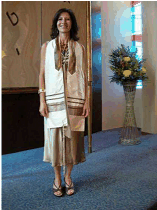My recent tallitot included collaborations, with....
1. Nathan, the bar mitzvah. He wanted a Tree of Life, "no leaves" (!), a blue background, stars on front. Machine appliquéd from dupioni silk, leaf-free.
2. Ian, another bar mitzvah. This artistic young man also wanted a Tree of Life, but he was okay with leaves - very specific leaves (orange, oval, just a few). He brought along a huge roll of paper that turned out to be a full-sized detailed drawing, and all the fabrics. He and his mom helped cut pieces and press under the seam allowances, in preparation for machine appliqué. The stripe of green butterfly fabric symbolizes his grandma. The fabrics are beautiful quilters' cottons:
3., 4. Monica & Edith, the mother and grandmother of the bat mitzvah. They chose dupioni silk. Monica's has copper dupioni stripes. Her atarah is an elegant brown gradation-dyed ribbon. (Monica's a graphic designer!) A beige, shiny bamboo ribbon-yarn was used for the tzizit (eco-kosher?). (One year followup: The bamboo yarn tzitziyot are not holding up well. They developed a fuzz. Let me know if you find something eco-kosher that holds up for the long run).
Edith's tallit (below) includes celadon, olive and gold dupioni stripes, and gold bamboo-based tzizit. Her atarah is a beautiful vintage embroidered ribbon that sat in my stash for years, awaiting this special simcha
5. Alan, the dashing Deadhead dad of a bar mitzvah. For him, the Jewish hippie mood was de rigueur. So I used a colorful hand-painted 100% cotton Ricky Tims fabric.
6. Eli, the bar mitzvah. He wanted photos from the Hubble Space telescope, plus a large spiral galaxy on back.. I pieced the latter, freeform log cabin style. This one is also 100% cotton.
...and a matching case from the scraps....
7. Danny, the cantorial soloist. I made his tallit from a gorgeous, heavy, green-braid embellished heavy linen tablecloth that he inherited from his mom.
8. Nina, rabbinical student and environmental activist, selected a ferny mottled turquoise and purple cotton batik; and a deep purple cotton for the lining. A matching case, and the small kippah were made from the same fabrics.
9. Katie, the bat mitzvah. She picked the colors and drew me a sketch. The stripes needed to be periwinkle, green and turquoise.. At first, she wanted pink circles appliquéd on top of the stripes. But after she saw them, she wanted gold five-pointed stars instead. I liked it both ways! All dupioni silk, unlined.
10. Moi. As far as I'm concerned, gazing upon the fabric of Kaffe Fassett is a religious experience (It's not him, it's his colors). But can I leave perfection alone? Ha! Thus the ungapatchked raw-edge appliquéd stripes and corners below, with more than a dozen different fabrics: Purple celtic knots, homespun taupe plaids, Kaffe's chili peppers, a vintage kimono fragment (the black/blue/yellow stripe), plus a wide swath of Liberty of London (famous for lack of austerity). And much more. I find that longer religious services are enhanced by the presence of most of my fabric stash. Quantity IS quality.
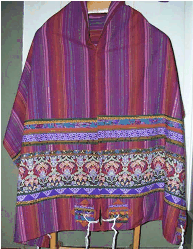
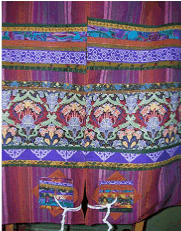

There are very few rules for tallitot, except that there must be correctly tied tzitzis in four corners (and different traditions have different ways to tie those knots!)
My tallitot are sometimes one layer, sometimes lined, with designs and decorations appliquéd on top. With my approach, after choosing the size, the base, and making the stripes, there are a several more steps:
LETTERING THE ATARAH
Tallitot can (but are not required) to have a long horizontal strip called an 'atarah' (plural atarot), along one long edge. The atarah may (but is not required to) include words or a blessing. For the tallitot described above, both youngsters told me they wanted the specific Hebrew blessing for donning the tallis on the atarah.
With an embroidery machine, making neat, professional quality Hebrew lettering is a snap (see 'Resources' 'Judaic Embroidery Designs').
Since I don't own an embroidery machine, here's my less snappy but equally effective approach:
On the computer, I type out the Hebrew blessing in the size I need. (An elegant font for Emi, a simpler one for Leo). (I buy my fonts from Davka - See 'Resources,' 'Putting Words onto Quilts.'). These are printed mirror image onto regular copy paper.
The sentences are cut into strips and taped together in the correct order. I spray the back (blank side) of the paper strip with temporary adhesive, and adhere it to the wrong side of a long strip of the atarah fabric. (Blue dupioni for Emi, blue cotton for Leo).
Load the top of the machine with thread that matches the fabric. Put on a free motion or darning foot. Load the bobbin with a thick decorative thread. (Metallic gold for Emi, a non-metallic thick Guterman polyester gold for Leo.)
From the back, stitch along the outlines of the printed letters. They show up gold on the front.
Gently tear away the paper. The next question is whether to fill in the letters, and, if so, how. For Emi's atarah, I used a Gold Sakura fine-tip paint marker. It makes an incredibly rich line on dupioni For Leo, I wasn't so sure. The marker didn't make as good an impression on cotton. So I let him decide. He liked the letter outlines, empty and floating, in the blue sky (Very kabbalistic. I approved.)
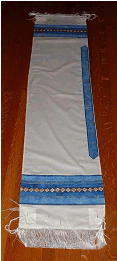
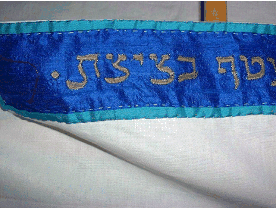
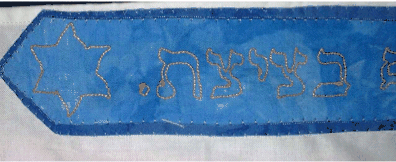
Thanks to Danny Chodos, my Hebrew teacher, editor, and dialogue coach for his valuable input on language customs, comic and cosmic timing. The best line in this essay is his.
More images of tallitot, made by other quilters, can be seen on my Gallery pages.


GLOSSARY
1. Tallit: Prayer shawl (pl: 'tallitot' or 'talliot): That's the Sephardic pronounciation. In Ashkenazi Hebrew, the singular is 'tallis' (pl: Tallesim).
2. Bar mitzvah or bat mitzvah: Literally, the terms refer to the youngster who is participating in a Jewish coming-of-age ceremony. ('Bar' means 'son of'; and 'bat' is 'daughter of.' The 'mitzvah' refers to the Torah commandments). One could say, 'The bat mitzvah looked wonderful in her new tallis and matching kippah!" However, in common parlance, bar and bat mitzvah have also come to be used for the ceremony itself, and even for the party. "The bat mitzvah looked wonderful at her bat mitzvah!" - That actually makes sense!
3. Ungapatchked: Yiddish for 'decoratively overwrought.' Victorians call it 'horor vacui.'
4. Machetunim: Yiddish. 'In-laws by marriage.'
5. Mchitza: Traditional barrier separating males from females at any orthodox Jewish ritual gathering. I was kidding about the cash register.
6. Kvetch: Yiddish, for 'complain.' Usually people. Sometimes, I learned from Leo, camels.
7. Shmata: Yiddish:. 'Rag.' Alternatively, whatever a decoratively overwrought Jew may be wearing.
8. Hiddur Mitzvot: Beautification of the Commandments. A longstanding principle of Jewish tradition: If you make it for HaShem, make it beautiful.





